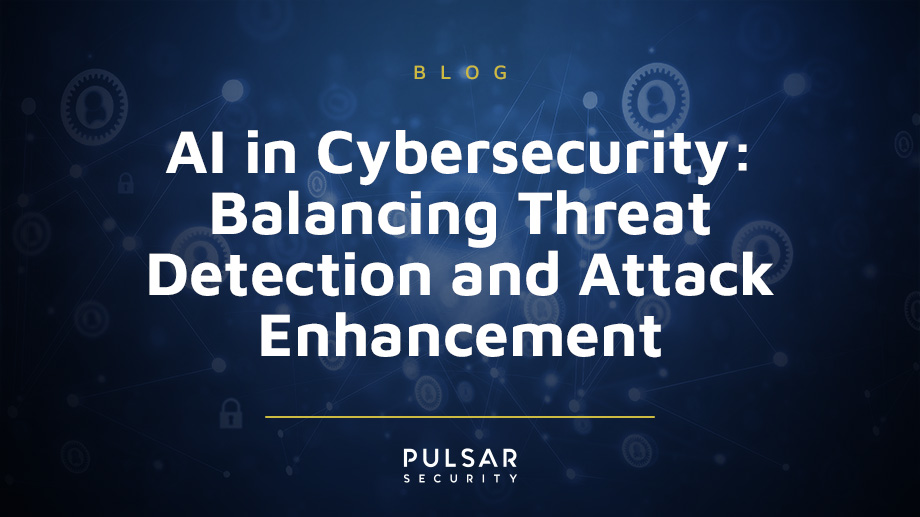AI in Cybersecurity: Balancing Threat Detection and Attack Enhancement
Imagine a prominent banking corporation being the target of an advanced cyber intrusion. Rather than devoting numerous hours to human-led investigation to comprehend and alleviate the risk, an AI/ML-driven cybersecurity solution can promptly detect the irregularity, analyze the menace instantaneously, and mitigate it before it inflicts substantial harm. This is the potential of AI and ML to revolutionize the cybersecurity field.
In the past few years, the integration of AI into cybersecurity has surged. The market worth of AI-powered cybersecurity, above $10 billion in 2020, is projected to increase to $46.3 billion by 2027, expanding at a compound annual growth rate (CAGR) of 25.51%. As 69% of enterprises deem AI crucial for tackling cyber threats, the corporate sector increasingly depends on it to secure its digital infrastructures.
How AI and ML are reshaping organizational cybersecurity strategies
1. Enabling predictive threat and anomaly detection
In cybersecurity, the capacity to anticipate is a powerful tool. ML shines in predictive threat analysis by examining past data, pinpointing patterns, and alerting potential future cyber threats. Picture possessing a time-travel device that can predict threats before they transpire. That's the wonder of ML!
ML algorithms serve a pivotal function in cybersecurity, encompassing:
- Uncovering a range of cyber intrusions
- Recognizing patterns that indicate security hazards
- Boosting the categorization and detection of cyber threats, such as identifying fraudulent activities and classifying phishing attacks
ML acts as our prophetic orb, enabling us to glimpse into the future and brace ourselves for it! Subsequently, it is becoming more vital, and 34% of companies are using it to predict potential security events, while 51% use it to detect and respond to anomalies.
2. Strengthening compliance
As AI incorporation in cybersecurity intensifies, so does its capacity to handle vast data. This capability is handy since rigorous privacy regulations, such as the GDPR in Europe and the CCPA in the USA, pose hurdles for different organizations. According to 2023 research, 90% of individuals expressed concern regarding data privacy, and 72% deemed current rules insufficient. Hence, regulatory bodies and governments are devising fresh guidelines for AI use in cybersecurity.
According to these novel regulations, organizations must actively gather and scrutinize threats and their potential impacts. Rather than concentrating solely on risk evaluations, businesses must adopt a more comprehensive approach to pinpoint threats and formulate strategies to tackle or avert them. AI provides a reliable approach that companies can use to predict those threats before they manifest and remediate them, which ensures compliance with applicable standards and regulations.
3. Automating anomaly threat detection
Although not all anomalies cause concern, they frequently signal potential security problems. AI can spot uncommon network traffic patterns and user actions, flagging potential cyber incursions or jeopardized assets. Specifically, AI systems employ behavioral analytics to set baseline patterns and detect deviant behavior that could suggest cybersecurity threats.
Furthermore, AI and ML algorithms sift through and scrutinize extensive data sets to boost security log analysis, diminish false positives, and enhance threat detection.
With AI standing guard, organizations can be confident that no irregularity slips through unnoticed. Besides, a recent study revealed that organizations can use AI/ML to automate almost 45% of cybersecurity processes, improving their ability to catch and prevent more threats efficiently.
Using ML and AI to prioritize risks more precisely
In 2023, a survey revealed that 41% of participants identified time as the principal challenge, followed by a shortage of personnel needed to carry out assessments. Furthermore, 38% of the respondents cited the need for more qualified professionals as one of the significant hurdles in assessing and prioritizing cybersecurity risks.
Despite this, prioritizing cyber risks is essential, especially in the modern digital era, where threats evolve and emerge constantly. Fortunately, the introduction of ML has revolutionized the formidable task of risk prioritization. ML facilitates risk prioritization by ranking cybersecurity incidents based on their potential aftermaths, enabling security teams to allocate resources to the most severe threats efficiently.
Also, cybersecurity is fundamentally dependent on risk evaluation. With the assistance of supervised ML, the risk assessment has become more precise and effective. It aids risk assessment by classifying network risks and predicting or categorizing factors linked to specific security threats. The strength of ML resides in its capability to:
- Utilize extensive datasets, such as historical threat data, to identify complicated patterns that are challenging for human analysis
- Leverage AI predictive models to anticipate potential vulnerabilities, enhancing focus on the most pressing and critical security challenges.
- Act as the trusted source we depend on for accurate risk assessment in the cybersecurity domain
Potential security risks from using USB drives
AI and ML have genuinely transformed how organizations approach cybersecurity. However, cybercriminals also use the technologies to devise deadly malware variants and craft more convincing social engineering attacks. Also, they can automate launching attacks, creating bots capable of carrying out large-scale phishing campaigns. Here are some additional potential negative impacts on cybersecurity:
1. Malicious actors can exploit AI
We often view technology as a ready-to-use tool, which isn't always the case. Even beneficial things have their downsides, and AI is no exception. AI algorithms are structured to sift through data and identify patterns swiftly. This benefits hackers who see this as an opportunity to access information or launch attacks on infrastructure.
For example, cybercriminals leverage this proficiency in pattern recognition and data processing to devise sophisticated phishing attacks. They can harness the power of AI to customize phishing emails with persuasive details, making them significantly more challenging to detect by conventional security measures.
Moreover, the self-governing nature of some AI systems paves the way for cyberattacks with unparalleled speed and scope. Once unleashed, malicious AI agents can independently modify their strategies to evade security protocols, leading to catastrophic outcomes for targeted systems and networks.
2. Creating spoofed websites to trick cybersecurity systems
Adversarial attacks can deceive security systems that depend on AI. Essentially, adversarial attacks happen when a malevolent actor tries to fool an ML system by altering its input data. For instance, a hacker might create a spoof website that appears to be the real deal, tricking the AI-based security system into thinking it's legitimate.
These counterfeit websites can be meticulously designed to exploit weaknesses in AI algorithms, such as flaws in image recognition or natural language processing. Attackers can carefully create content to imitate real interactions to avoid detection and gain unauthorized access to sensitive information or systems.
Furthermore, attackers can use generative adversarial networks (GANs) to create hyper-realistic website duplicates virtually indistinguishable from the real ones. This advanced technique allows attackers to create deceptive online environments that bypass even the most advanced AI-powered security measures.
3. AI-powered ransomware
Traditional ransomware operates like a rigid automaton, following predefined rules and static encryption algorithms. AI-powered variants, however, learn, adapt, and evolve. They analyze their environment, learn from its interactions, and adjust their attack vectors dynamically. These AI-driven ransomware strains can evade detection mechanisms, making them formidable foes.
Moreover, AI-powered ransomware assesses system configurations, vulnerabilities, and potential loot. Armed with this intelligence, it selectively strikes high-value targets—critical infrastructure, financial institutions, or healthcare organizations. The result? Maximum impact and potentially astronomical ransoms.
At the same time, AI-driven ransomware learns and adapts in real time. It monitors system behavior, network traffic, and user interactions. When it senses something amiss, it recalibrates its tactics. Delayed encryption during off-peak hours? Check. Is it mimicking legitimate processes? Absolutely.
How organizations can deal with these threats
Integrating AI and ML in cybersecurity presents both an opportunity and a challenge. The power of these technologies can be harnessed to fortify defenses. However, the same AI and ML capabilities can be weaponized to launch advanced cyber-attacks, creating a new breed of more elusive and destructive threats.
In this era of digital transformation, AI and ML are not just tools but strategic imperatives in cybersecurity. Their effective use in cybersecurity depends on a holistic approach that integrates technology, processes, and people. It requires continuous learning and adaptation in an evolving threat landscape.
The way forward - getting expert assistance
Luckily, a cybersecurity firm equipped with certified professionals, round-the-clock monitoring systems, and real-time alerts plays a pivotal role in this landscape. These firms are the vanguard in leveraging AI and ML to predict, prevent, and respond to threats with unparalleled speed and precision. They transform the cyber warfare landscape by turning vast data into actionable insights.
Additionally, they keep up with today's cyber threats and anticipate tomorrow's cyber threats. As we continue to push the boundaries of AI and ML in cybersecurity, we must also push the boundaries of our understanding, ethics, and governance. Only then can we truly realize the promise of AI and ML in creating a safer and more secure digital world.
Pulsar Security is a notable player in AI/ML. Their expertise enables organizations to harness the power of AI in cybersecurity, while fortifying defenses against AI-powered attacks. This dual capability positions Pulsar Security as a strategic partner in the journey towards a secure digital future.
You can contact us today to learn more about our security solutions to enhance the protection of your organization.

Corey Belanger
Corey is a Security Consultant and leads QA of product development, using his expertise in these dual roles to more effectively test and secure applications, whether while building enterprise applications or while performing penetration tests and vulnerability assessments for customers. An Army veteran with a tour of duty in Afghanistan, Corey has built a post-military career in security while earning Network+, Security+, GIAC Certified Incident Handler, GIAC Python Coder, GIAC Web App Penetration Testing, and GIAC Penetration Tester certifications. Corey is also a BsidesNH organizer and founding member of TechRamp, avenues which he uses to help others build their skills for careers in security and technology. Fun Fact: When not manning a terminal or watching the Bruins, Corey can often be found snowboarding or riding his motorcycle.




